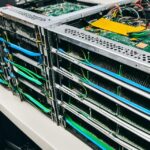How Recycled Servers Are Powering New Technologies
Recycled Server Technologies are revolutionising the tech industry, fostering sustainability and innovation in the UK. In an era where environmental consciousness is becoming increasingly important, the carbon footprint of cloud-based processing is a concern for the tech industry. Cloud services require a significant amount of energy to power the servers and cool the data centres, but recycled server technologies are changing the game.
Companies are taking steps to reduce their carbon footprint by using renewable energy sources and implementing energy-saving initiatives. Legislative and regulatory pressure is also driving the adoption of sustainable practices in tech design. The shift towards a circular economy is a key focus, with companies aiming to extend the lifespan of server components through maintenance, refurbishment, and reuse.
The Environmental Impact of Cloud Services
Cloud services have become a vital component of the tech industry, but their energy consumption and carbon footprint can undermine their contribution to decarbonisation efforts. However, many cloud service providers, such as AWS, Microsoft Azure, and Google Cloud, are actively working to reduce their environmental impact.
These companies have set goals to transition to 100% renewable energy and are entering corporate power purchase agreements to support the development of renewable energy infrastructure.
Additionally, innovations in data center location and cooling technologies are helping to minimize energy requirements and maximize efficiency. The shift towards renewable energy and energy-saving initiatives is crucial for reducing the environmental impact of cloud services.
Cloud services have gained immense popularity due to their scalability, reliability, and cost-effectiveness. However, the rapid growth of cloud computing has raised concerns about its environmental impact. The energy consumption of data centers, which power cloud services, contributes significantly to carbon emissions and global energy consumption.
According to a report by Greenpeace, if the cloud computing industry were a country, it would rank sixth in the world in terms of electricity consumption. The energy required to power and cool data centers, along with the carbon emissions associated with non-renewable energy sources, have led to a substantial carbon footprint.
To address this issue, cloud service providers are actively embracing renewable energy solutions to power their infrastructure. By shifting to 100% renewable energy, these companies not only reduce their carbon footprint but also support the growth of renewable energy sources. Their commitment to renewable energy is demonstrated through power purchase agreements, where they directly invest in renewable energy projects to offset their energy consumption.
Benefits of Renewable Energy Adoption
The transition to renewable energy brings several benefits in terms of environmental sustainability and long-term cost savings:
- Reduced carbon emissions: Renewable energy sources, such as solar and wind, have minimal or no carbon emissions, helping to mitigate climate change and reduce air pollution.
- Long-term cost savings: Renewable energy can provide stable and predictable costs, ensuring financial savings for cloud service providers in the long run. This stability is particularly important given the volatility of fossil fuel prices.
- Energy independence: By generating their own renewable energy, cloud service providers can reduce their reliance on traditional energy sources, enhancing their energy security and resilience.
Innovations in Data Center Efficiency
In addition to renewable energy adoption, cloud service providers are constantly striving to improve the efficiency of their data centers. Innovations in data center location and cooling technologies play a crucial role in minimizing energy consumption and maximizing efficiency.
Data centers are strategically located in areas with a favorable climate to reduce the need for excessive cooling. They utilize advanced cooling techniques, such as free cooling, which take advantage of natural cool air or water sources to maintain the optimal temperature for servers.
Furthermore, technologies like server virtualization and data deduplication enable the consolidation of multiple servers into a single physical server, reducing energy consumption and optimizing resource utilization.
The continuous improvement in data center efficiency not only helps to reduce the environmental impact of cloud services but also enhances the overall performance and reliability of these services.
Legislative and Regulatory Pressure for Sustainability
Legislative and regulatory measures play a crucial role in driving tech companies to adopt sustainable practices. Recognizing the decarbonisation imperative and the importance of environmental considerations, governments and international bodies are taking steps to promote eco-design and regulate AI’s impact on the environment.
One notable example is UNESCO’s agreement on the ethics of AI, which emphasizes the need for resource-efficient AI methods and discourages investments in environmentally impactful AI systems. This agreement highlights the growing recognition of the environmental consequences of AI technologies and the urgency to address them.
“We must prioritize sustainable and resource-efficient AI to protect our planet for future generations.”
In France, proposed legislation aims to reduce the environmental impact of digital technology and promote eco-design. It seeks to hold tech companies accountable for their products’ environmental footprint and encourage the use of sustainable materials and manufacturing processes.
Telecoms regulators are also taking significant steps towards environmental protection. They may be empowered to collect information on the environmental footprint of the electronic communications sector and impose measures to mitigate its impact. This regulatory oversight ensures that tech companies consider environmental considerations in their operations and strive for sustainable choices.
The Significance of AI Regulation
AI regulation plays a critical role in shaping the tech industry’s approach to sustainability. By enforcing strict environmental standards, regulators can encourage the adoption of eco-friendly practices, minimize energy consumption, and reduce the carbon footprint of AI technologies.
Regulatory frameworks can incentivize innovation in eco-design, driving tech companies to prioritize sustainability and develop products with a reduced environmental impact. By setting clear guidelines and targets, regulators ensure that the tech industry embraces sustainable choices in AI development and deployment.
Embracing Eco-Design in Tech
Eco-design is a key aspect of sustainable tech development. By incorporating environmental considerations in every stage of the product lifecycle, from design to disposal, tech companies can minimize resource consumption, reduce waste, and maximize the longevity of their products.
Eco-designed technologies prioritize energy efficiency, recycling capabilities, and the use of sustainable materials. They are developed with a circular economy mindset, aiming to minimize environmental harm and facilitate the reuse and recycling of components.
Successful eco-design practices require collaboration between innovators, policymakers, and industry experts. By working together, they can create a regulatory framework that encourages the tech industry to embrace sustainable choices, leading the way to a greener and more environmentally responsible future.
| Impact of Legislative and Regulatory Measures | Key Takeaways |
|---|---|
| 1. Encourages tech companies to prioritize sustainability | 1. Tech companies are compelled to adopt sustainable practices |
| 2. Discourages investments in environmentally impactful AI systems | 2. AI development focuses on resource-efficient methods |
| 3. Holds tech companies accountable for environmental footprints | 3. Companies consider the environmental impact of their products |
| 4. Promotes the use of sustainable materials and manufacturing processes | 4. Eco-design is prioritized in tech product development |
The Circular Economy and Recycled Server Technologies
The circular economy provides an opportunity for the tech industry to embrace sustainable practices and reduce waste. Recycled server technologies play a crucial role in achieving this goal, with a focus on maintenance, refurbishment, reuse, and recycling of server components.
By extending the lifespan of server components through maintenance and refurbishment, companies can maximize the use of existing resources and minimize waste. Instead of disposing of servers when they become outdated or faulty, companies can repair and replace parts with refurbished inventory.
Additionally, the circular economy approach encourages the reuse and recycling of unused server components. Instead of discarding these components, they can be resold or repurposed, reducing the need for new materials and minimizing the environmental impact.
Embracing the circular economy in data centers has significant environmental and economic benefits. It increases the landfill diversion rate, reduces resource consumption, and fosters a more sustainable and efficient tech industry.
“The circular economy is not just about waste. It is about decoupling economic growth from resource consumption and creating new business opportunities through sustainable practices.” – Ellen MacArthur Foundation
The Benefits of the Circular Economy in Recycled Server Technologies
The benefits of adopting a circular economy approach in recycled server technologies are numerous:
- Reduces electronic waste: By maximizing the lifespan of server components through maintenance, refurbishment, reuse, and recycling, the amount of electronic waste generated is significantly reduced.
- Conserves resources: Reusing and recycling server components reduces the need for new materials, conserving valuable resources such as metals and minerals.
- Minimizes carbon footprint: By extending the lifespan of servers and reducing the demand for new manufacturing, the carbon footprint associated with server production and disposal is minimized.
- Promotes sustainable practices: Embracing the circular economy in the tech industry encourages the adoption of sustainable practices, fostering innovation and driving the development of new business models.
This table showcases the environmental and economic benefits of the circular economy in recycled server technologies:
| Environmental Benefits | Economic Benefits | |
|---|---|---|
| Reduces electronic waste | Minimizes landfill usage and hazardous materials | Lower disposal costs and potential revenue from component reselling |
| Conserves resources | Reduces resource extraction and energy consumption | Lower material and production costs |
| Minimizes carbon footprint | Reduces greenhouse gas emissions from manufacturing and disposal | Savings on energy and carbon taxes |
| Promotes sustainable practices | Drives innovation and development of eco-friendly technologies | Opportunities for new business models and market growth |
Data Center Heating and the Circular Economy
The excess heat generated by data centers can be harnessed for heating homes and offices, contributing to the circular economy. Initiatives in countries like Sweden and the Netherlands have utilized waste heat from data centers to warm homes and reduce reliance on natural gas. This approach not only provides a more sustainable heating solution but also offers cost savings for consumers. Data-center heating systems, powered by direct liquid cooling, transfer heat away from servers and deliver it to buildings. This innovative application of recycled server technologies has the potential to transform the heating industry and contribute to a greener and more efficient energy system.
By tapping into the data-centre heating market, businesses can reduce their energy bills while also utilizing waste heat that would otherwise go to waste. This not only reduces operational costs but also contributes to a more sustainable approach to energy consumption. By implementing circular economy practices and leveraging waste heat, companies can reduce their environmental impact while maximizing the efficiency of their operations.
Case Study: Data Center Heating in Sweden
Sweden leads the way in utilizing waste heat from data centers for heating purposes. The country has an extensive district heating network that distributes the excess heat generated by data centers to residential and commercial buildings. This approach has significantly reduced the carbon footprint of heating systems, as natural gas consumption has decreased. Consumers benefit from lower energy bills and a more sustainable heating solution, contributing to a greener and more efficient energy system.
Benefits of Data-Center Heating
The application of recycled server technologies for heating offers several benefits:
- Reduced energy bills for consumers
- Lower carbon footprint and greenhouse gas emissions
- Less reliance on natural gas and fossil fuels
- Contributions to the circular economy by utilizing waste heat
- Promotion of sustainable and efficient energy practices
The Future of Data-Center Heating
The data-centre heating market is expected to experience significant growth in the coming years. With the increasing demand for sustainable and efficient energy solutions, businesses and consumers are seeking alternative heating options. The utilization of waste heat from data centers aligns with circular economy practices and provides financial benefits for both parties involved. As more countries and organizations recognize the potential of recycled server technologies, the market for data-center heating is set to expand.
Data-Center Heating Market Forecast
Table: Data-Center Heating Market Forecast
| Year | Market Value (USD Millions) |
|---|---|
| 2022 | 500 |
| 2023 | 750 |
| 2024 | 1,000 |
| 2025 | 1,250 |
The data-centre heating market is projected to reach a value of over $1.2 billion by 2025, indicating the growing market potential and the increasing adoption of recycled server technologies for heating purposes. With the energy savings and environmental benefits it offers, data-center heating is poised to transform the heating industry and contribute to a more sustainable and efficient energy system.
Financial Incentives and Market Potential
Using data centers for heating not only benefits the environment but also offers financial incentives. Market predictions indicate that the data-centre DLC market will continue to grow, reaching a value of over $2.5 billion by 2025. Companies that adopt data-center heating systems can profit from the sale of excess heat while customers enjoy reduced energy bills.
For example, consumers choosing DLC cooling can receive a cash incentive equivalent to a percentage of their electricity costs.
| Financial Benefits of Recycled Server Technologies |
|---|
| Reduced energy costs |
| Sale of excess heat for profit |
| Financial incentives for consumers |
The combination of environmental benefits and financial opportunities makes recycled server technologies an attractive option for both businesses and consumers.
Conclusion
Recycled Server Technologies are revolutionizing the tech industry, fostering sustainability and innovation. As the carbon footprint of cloud services raises concerns, companies are actively addressing the environmental impact by adopting renewable energy sources and implementing energy-saving initiatives.
Legislative and regulatory measures are pushing for sustainable choices and design in the tech industry. Embracing the circular economy approach, companies are extending the lifespan of server components through maintenance, refurbishment, reuse, and recycling, minimizing waste and maximizing resource efficiency.
Furthermore, the application of recycled server technologies for heating homes provides a greener and more efficient energy solution. By harnessing the excess heat from data centers, this innovative practice contributes to the circular economy and reduces reliance on traditional heating methods.
The market potential for data-center heating, coupled with the financial incentives it offers, makes embracing recycled server technologies even more enticing. By combining sustainability, circular economy principles, and innovation, the tech industry can create a more environmentally friendly and economically viable future.
FAQ
What is the environmental impact of cloud services?
Cloud services require a significant amount of energy to power the servers and cool the data centers, resulting in a carbon footprint. However, many cloud service providers are actively working to reduce their environmental impact by using renewable energy sources and implementing energy-saving initiatives.
What legislative and regulatory measures are in place for sustainability in the tech industry?
There are various measures being implemented to encourage tech companies to adopt sustainable practices. For example, UNESCO’s agreement on the ethics of AI includes an environmental angle, urging AI actors to favor resource-efficient methods. Proposed legislation in France aims to reduce the environmental impact of digital technology and promote eco-design. Telecoms regulators may also play a role in collecting information on the environmental footprint of the electronic communications sector and imposing measures for environmental protection.
How does the circular economy relate to recycled server technologies?
The circular economy presents opportunities for the tech industry to embrace sustainable practices and reduce waste. Recycled server technologies focus on extending the lifespan of server components through maintenance, refurbishment, reuse, and recycling. By repairing and replacing parts with refurbished inventory, companies can maximize the life of servers and minimize waste, while also reducing the need for new materials.
How can data centers contribute to the circular economy?
The excess heat generated by data centers can be harnessed for heating homes and offices, contributing to the circular economy. Initiatives in countries like Sweden and the Netherlands have utilized waste heat from data centers to warm homes and reduce reliance on natural gas. Data-center heating systems powered by direct liquid cooling transfer heat away from servers and deliver it to buildings, offering a sustainable heating solution and cost savings for consumers.
What are the financial incentives associated with recycled server technologies?
Market predictions indicate that the data-center DLC (Direct Liquid Cooling) market will continue to grow, reaching a value of over .5 billion by 2025. Companies that adopt data-center heating systems can profit from the sale of excess heat, while customers enjoy reduced energy bills. For example, consumers choosing DLC cooling can receive a cash incentive equivalent to a percentage of their electricity costs, making recycled server technologies an attractive option for both businesses and consumers.















